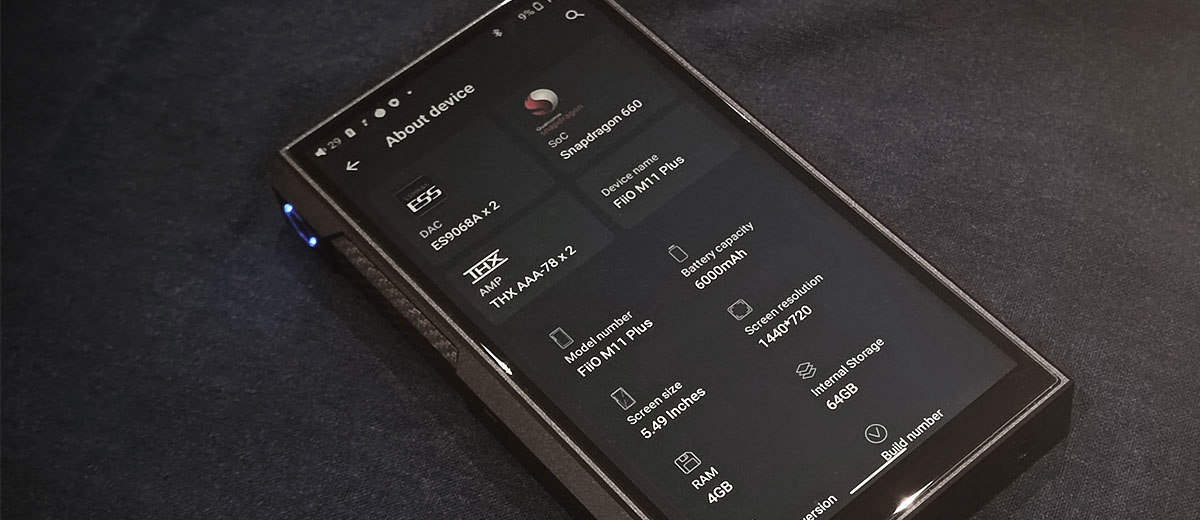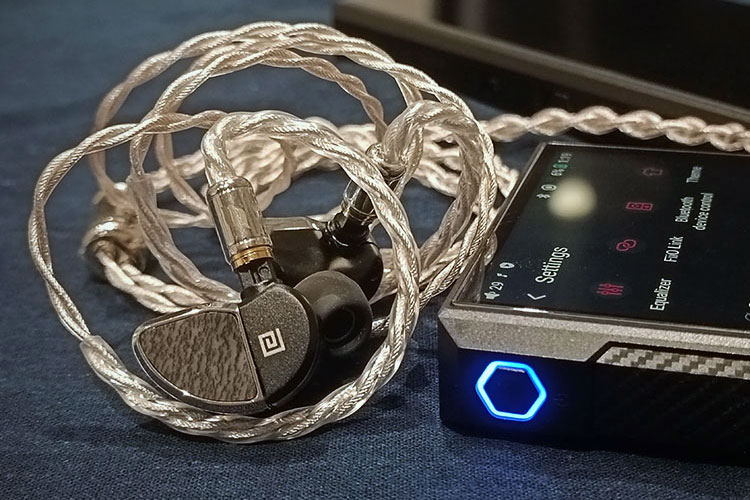Sound Impressions
Summary
The ESS ES9068AS DAC chips replacing AK4497EQ have been used on various portable audio products including Shanling M6 Pro 21 and Astell & Kern Kann Alpha. The experience with these devices using ESS chipset replacements is so far so good.
This time with the same THX AAA module in the M11 Plus ESS version, the timbre and power in the output are arguably similar to the LTD version, with the LTD version being noticeably warmer and the ESS version pushing out more edges in the upper mids for stronger texture, resulting in a more analytical, cleaner tone that put the focus more to the two ends.
The below impressions are made after weeks of burn-in with different IEMs on both the SE and balanced connection and are based on the default filter settings in Pure Music Mode.
With other apps, the tonality may change so it is recommended to try other music apps such as UAPP, Kaisertone, Onkyo Player, etc., which could bring about more synergy with various IEMs.
Timbre
While The M11 Plus LTD has a rather balanced signature and a slight hint of warmth, the M11 Plus ESS version goes cleaner and less full in the mid-bass. This results in a more analytical, uncolored timbre that works nicely with IEMs tilted to the lower end or elevated in the midrange frequencies.
I would still consider the M11 Plus ESS to sound balanced without any frequencies being pushed out. Without the warmth or elevation in mid-bass, the M11 Plus ESS is good at revealing treble details with almost all IEMs being paired.
Balanced connections yield audibly better results on the M11 Plus ESS where the bass punch is more solid and agile. The upper frequencies are rendered smoother, more controlled, and with more air. Staging and the overall swiftness in articulation are also noticeably better using the DAP’s balanced output.
Staging & Imaging
The clean touch in the midrange brings out more details in the upper register and in the lows which helps to reveal more airy details that stretch the staging deeper and boost the dynamic range.
On M11 Plus ESS, the focus is more on resolution and it enhances the transient response in the upper frequencies, which gives a more distinct positioning to cymbals and other higher-pitched instruments, as well as the vocalist.
The bass is well layered and decays rather speedily to keep the pace fast and controlled, while the instrument’s imaging is well defined with good intensity.
The vocal image is more confined than on the M11 Plus LTD but it is positioned clearly. String plucking on the double bass or bass guitars is clean in attack while not lacking body, where good balance and separation between the instruments are maintained.
Synergy
Efficiency
As far as delivering a dark background is concerned the M11 Plus ESS is satisfactory with the noise level measured at ≤2.5μV. Using sensitive IEMs like the Shure SE846 you should hear none to very faint hisses with a near-silent background and a high level of dynamic range.
There are 3 gain levels and at a higher gain, some sensitive earphones may pick up more noise but it is negligible when listening outdoors. There are also some fine volume steps to allow users to turn to the optimal volume level without shocking their ears.
Pairings
Multi-BAs
Testing with BA-only designs such as the Oriolus Mellianus and Etymotic EVO, the output is clean and accurate. The bass kicks pretty deep with a rather fast decay to keep the output clean, and the vocal frequencies are pushed. A gentle lift in the upper mids helps voices to cut through the mix and be separated from the backing track well.
The presentation is quite clean and I won’t consider it clinical or harsh with the upper mids being well controlled even at higher volume, you could always give the bass frequencies a nudge in the equalizer menu to warm up the bass and bring out a bit more emotions, especially with lower impedance IEMs that may sound more neutral on the M11 Plus ESS.
It sounds exciting and transparent when listening to instrumentals and JPop with multi-BA IEMs with decent resolution and layering in the bass. There is enough power on the M11 Plus ESS to drive multi-BAs well.
Hybrids
On hybrid IEMs such as the Effect Audio Axiom with the “YU” module, the bass has a rather fast and punchy attack that aligns with the clean signature and feels unaltered in tone.
Hybrid IEMs that are often tuned to sound fuller, more textured, or more forwarded in the mid-range will have better synergy with the M11 Plus ESS. You can hear it being able to power some demanding IEMs quite well.
The M11 Plus ESS has enough power and speed to drive the dynamic drivers in hybrid IEMs to sound punchy in the lows while boosting the treble details gently. The signature also favors such pairings to emphasize the dynamics and clarity.
Dynamic IEMs
The M11 Plus ESS works well with dynamic IEMs I tested and even entry-level dynamic IEMs such as the A4000 from Final sound pretty engaging with it.
Putting on the FAudio Dark Sky there is good energy in the bass that kicks deep and sounds well layered. The articulation in the mid-range frequencies is very smooth with a V-shaped signature that helps deliver strong transients and bass attack for fast electronic music.
Treble is nicely textured on the M11 Plus ESS with a small bump in the higher register which enhances the perceived clarity for upper-register vocals that offer a good level of definition and power.
Planar IEMs
Testing with the Dethonray Tender 1 planar IEM the midrange has great fullness with impressive bass detail. Good bass layering is presented with the M11 Plus ESS doing a good job in getting the Tender 1 under control while outputting strong dynamics and very airy bass.
The tuning will appeal more to those who seek uncolored vocals or cooler signatures. When you feed the M11 Plus ESS with well-mastered, higher-resolution tracks it can sound dense and elaborative in the mids.
In general, you can expect bassy, mid-centric IEMs also IEMs that need a little bit more sparkle in the upper register to match well with the M11 Plus ESS.
Select Comparisons
FiiO M11 Plus LTD
$799
Technical
Aside from the difference in DAC chips, we have spotted quite a few differences in the specs. The LPF is changed to OPA927x2 from the OPA1642x2 on the LTD version. THD+N figures improved from <0.00079% on the LTD to <0.0006% on the ESS version and SNR dropped a little bit to ≥118dB from >121dB, while the noise floor is also 0.6μV more on paper.
On single-ended output, the M11 Plus ESS version is always more powerful in the output, especially when with a higher load. It achieves ≥33mW on a 300Ω load compared to ≥23mW only on the LTD.
The SNR is also stronger on the ESS version measuring 122dB, which is 2dB more than the LTD version. With regards to the balanced configurations, the M11 Plus ESS can get as high as ≥660mW in the output while the LTD can only go up to 588mW. The SNR is also higher on the M11 Plus ESS reaching 126dB and the LTD gets up to 120.5 dB.
It takes roughly 30 mins more to be completely charged with the ESS version, but the battery life is 40% more on a balanced connection. The output power is even stronger, so it seems true that the ES9068AS is much more power-efficient while not compromising technicalities.
Design
The two DAPs are basically from the same mold. The ESS version is 15g lighter in weight as well but in the hand, you may not be able to feel much difference.
The carbon fiber textured slider button on the M11 Plus ESS is cooler to me and enhances the experience, as well as the grip of the original plain slider on the M11 Plus LTD, which is a bit too smooth.
Another way to tell which player is which would be to look at the diamond cutback panel, where the ESS version is more tinted in blue.
Performance
In general, the M11 Plus ESS version has a more balanced and clean tuning as the midrange is not as forward and colored as the LTD version. It sounds more resolving with your attention shifted to the details in the upper mids.
Looking at the 40% more playback time I had doubts whether it would perform as well, but the actual performance is quite convincing. The M11 Plus ESS achieved similar decoding quality and a seemingly stronger output level.
There is a bigger difference when testing with sensitive IEMs. The LTD version sounds more dynamic and lusher in the mids and the ESS version is cleaner and less intense in the bass. The variance in tuning is narrowed down when using higher-impedance gears, but you can still hear more warmth in the LTD version.
Overall, the LTD sounds more rounded, warmer, and fuller in the mid-lows for most pairings. In contrast, the ESS version emphasizes the technicalities more and has a lighter touch in the midrange frequencies, which paints the output smoother, more open, and less colored.
Shanling M6 Pro 21
$799
Technical
The comparison with the M6 Pro 21 gets more interesting as the same DAC chipset is used for decoding. The M6 Pro 21 reaches a higher output rating at 760mW in its ultra-high gain mode, compared to the 660mW maximum on the M11 Plus ESS.
The SNR goes head-to-head using the balanced configuration. Both measured to be 126dB while channel separation on the M6 Pro 21 is 1dB less than the M11 Plus ESS which achieves ≥111dB at 1kHz/32Ω.
As for THD+N, the M6 Pro 21 takes the lead measured at 0.0005% and the M11 Plus ESS is marked ≤0.00085%, both units are doing quite well in this aspect.
Another difference would be the <2Ω impedance on the M11 Plus ESS compared to the ≤0.6Ω on the M6 Pro 21, which gives it some advantage to sound more accurate with very sensitive IEMs or CIEMs.
Design
It is not the first time for us to compare Shanling and FiiO products which take a very different approach to design while being similar in size.
The Shanling M6 Pro 21 is more rounded with a cool curved screen, while the M11 Plus ESS feels techier and uses an innovative slider volume button that offers a newer experience. The M6 Pro 21 does not need a pin pusher to unlock the card slot and I like that approach.
The presence of the multi-function button on the M11 Plus ESS is what makes the difference, allowing users to operate the DAP more efficiently and intuitively especially when operating single-handedly.
In terms of UI design, the M11 Plus ESS with Android 10 has enhanced graphics and is customized to a deeper level. The fact that Google stopped supporting Android 7, the M6 Pro 21 with Android V7.1 OS is more prone to security threats if you are using other non-music apps that require login.
The M11 Plus ESS has a bigger 6000mAh battery and the M6 Pro 21 only has 4000mAh inside, yet their playback hours are roughly the same. This is likely due to the more power-consuming SoC on the M11 Plus ESS.
Performance
While the same DAC chipsets are being used, what brings about the difference in sound is the amping circuitry design. Both DAPs feel equally powerful and should be satisfactory for most IEMs in the market.
Comparing the balanced output, the M6 Pro 21 feels more delicately tuned for smooth and intense mid-treble, having the vocal being more forwarded and polished.
This makes it sound more resolving and sweeter especially when listening at a lower volume or with sensitive CIEMs. There is also more penetration power for strings and flutes, with a great balance maintained throughout the frequency spectrum.
Comparatively, the M11 Plus ESS has a more V-shaped signature, and the bass is slightly more expressive and protruded in the mid-bass area. With rock and pop, it sounds more analytical in the upper registers and also deeper in staging, while the bass punch is not as deep as the M6 Pro 21.
On the M11 Plus ESS, the vocal isn’t as polished as the M6 Pro 21, which is shaped for enhanced lushness. With some hoarse or darker voices, it may feel more realistic and it allows more of the backing instruments to be heard.
When you turn on the All To DSD mode on the M11 Plus ESS, the vocal gets smoothened and the treble texture comes closer to the M6 Pro 21 while sounding more layered in the bass.
Our Verdict
With the FiiO M11 Plus ESS, we can see the company’s effort is not merely focused on swapping out the chipset solutions. The M11 Plus ESS displays great technicalities, balance, and a swift, light-hearted signature that sounds expansive and smooth with pops, rock, and instrumentals.
There is satisfactory output power and clarity with most IEMs and the signature allows very easy pairing, even with some budget IEMs and earbuds that always lean more to the bass.
Overall, the highly responsive and feature-rich UI plus the hardware features come together as an enjoyable product experience, marking the M11 Plus ESS as one of the most versatile players in sound with a modern and appealing design to go along with it.
FiiO M11 Plus ESS Specifications
- Controller model: Qualcomm Snapdragon 660
- DAC chips: ES9068AS*2
- Amplifier: THX AAA-78*2
- Screen: 5.5” 1440×720
Dimensions: 136.6×75.7×17.6mm - Weight: ~295g
- USB: TYPE C Two-way USB 3.0
- Battery: 6000mAh
- Battery life: >14hr for PO; >14hr for BAL
- Charging time: About 3.5hrs
- PO Output power: 300mW(16Ω)
- BAL Output power: 660mW(32Ω)
- Frequency response: 20Hz~80kHz(-5dB)
- SNR: ≥126dB
- THD+N: <00085% (A-weighted)
- Noise floor: <5μV
- Output impedance: PO≤1Ω;BAL≤2Ω
- DSD decoding: up to DSD 256






